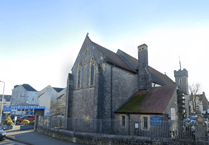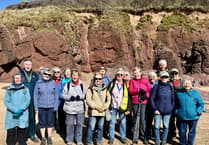Author John Woodcock has launched his latest book looking at the history of Tenby’s buildings.
‘Tenby Historic Buildings’ is the fourth book in a series describing various aspects of the history of the town and Caldey Island, the others being ‘Tenby Shops 1870 to 1970’, ‘Tenby History’ and ‘Caldey Island History’.
In Tenby there are 346 listed buildings and structures of which 3 are Grade I listed and the rest are Grade II* and Grade II. There is also one scheduled ancient monument.
A scheduled monument is defined as an ancient, and uninhabited structure, such as, for example, Stonehenge. The only example in Tenby is Scotsborough House (described in Chapter 11 of this book) which was built in the early fifteenth century but now in a ruinous condition.
The three Grade I listed buildings are - the town walls, the Parish Church of St. Mary the Virgin and the Tudor Merchant’s House.
“Buildings are listed as Grade I when they are considered to be of exceptional interest, and Grade II* when they are important buildings of more than special interest, and Grade II when they are buildings of special interest warranting every effort to preserve them,” said John, who first visited Tenby with his family in the late 1970s and they have enjoyed many holidays in the town since.
“In this book I have photographed and described all the listed buildings, and also included a chapter on what Tenby actually looked like at the beginning of the nineteenth century prior to the large building programme which then took place.”
The book features chapters on the defences of Tenby including the castle and the town walls, churches and chapels, the railway station, St. Mary’s, the Tudor Merchant’s House, St. Catherine’s island, the harbour, the De Valence and South Beach pavilions, Scotsborough House and Sion House.
“The aim of this book is to show what Tenby was like when John Wesley Visited in 1784 and commented: ‘I think there is not such a town in England. Two-thirds of the ancient town are either in ruins or vanished away’ - and then to show how enterprising individuals worked to produce the lovely town we see today,” explained John.
“The buildings of Tenby are a precious resource and the hope is that this book will encourage people to look more closely at the historic buildings which are such an important part of Tenby’s heritage,” he continued.
“I owe a large debt of gratitude to my wife June, and my family who have supported me during my research. I am also indebted to Mark Lewis, curator of Tenby Museum and Art Gallery; Neil Westerman and Kevin Thomas, also of the Museum; and Albie Smosarski for their encouragement and support.
“Finally, I would like to thank Matt of Matt Swann Creative Ltd. It has been a pleasure to work with him on all four volumes,” added John.
‘Tenby Historic Buildings’ is available to purchase at Tenby Bookshop on Tudor Square and at Tenby Museum and Art Gallery.





Comments
This article has no comments yet. Be the first to leave a comment.